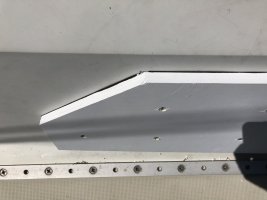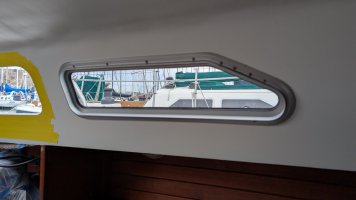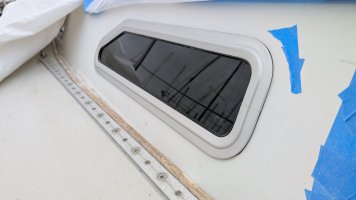Guest viewing is limited
- You have a limited number of page views remaining
- 26 guest views remaining
- Register now to remove this limitation
-
Untitled Document Join us on April 25th, 7pm EDT
for the CBEC Virtual Meeting
EY.o April Zoom Meeting
All EYO members and followers are welcome to join the fun and get to know the people you've met online!
See the link below for login credentials and join us!
(dismiss this notice by hitting 'X', upper right)
You are using an out of date browser. It may not display this or other websites correctly.
You should upgrade or use an alternative browser.
You should upgrade or use an alternative browser.
Replacing Fixed Windows Research [Master Thread]
- Thread starter mherrcat
- Start date
-
- Tags
- replacement research windows
See also:
 ericsonyachts.org
ericsonyachts.org
 ericsonyachts.org
ericsonyachts.org
window
Window / Portlight repair or replace
On my 1972 35-2 the portlights were leaking, and faced with the choice of seeking out the leak or pulling the portlights (boat windows) and repairing, or buying new portlights, I chose to pull and repair the portlights. To replace was gonna be around $3,200, while reseating and repairing under...
Recent threads, some of them with historical opinions, recommend butyl rubber for portlight frame installation into the cabin house.
I feel (strongly) that caulk is much better for portlights. Yes, butyl is marvelous for deck fittings, as popularized by Mainesail. I don;t think he ever suggested using it for portlights.
Butyl requires pressure, which bolted deck fittings provide in spades. Ericson portlights are not bolted on. They're held in place mostly by the low adhesion of the sealant, and the flange which resists forces from the outside (breaking waves). The interior cover, with its many screws, is mainly cosmetic, and if you honk down on the screws it just bends the aluminum and ruins the cover.
The openings for portlights in the Ericson cabin house are famously approximate, presumably so the metal of the frame has a little float. In any case, they were not made as precision holes for a tight fit. There can be gaps. Caulk, by its nature, flows to fill gaps. Butyl doesn't have the same property.
Painters tape makes caulk overflow on the exterior easy to clean up. Caulk doesn't ooze over time, either, as butyl can. I've replaced portlights both ways and concluded that caulk is the way to go.
Butyl works, but caulk is better. Use lots of it, as Ericson did.
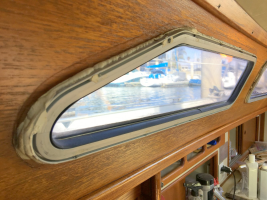
I feel (strongly) that caulk is much better for portlights. Yes, butyl is marvelous for deck fittings, as popularized by Mainesail. I don;t think he ever suggested using it for portlights.
Butyl requires pressure, which bolted deck fittings provide in spades. Ericson portlights are not bolted on. They're held in place mostly by the low adhesion of the sealant, and the flange which resists forces from the outside (breaking waves). The interior cover, with its many screws, is mainly cosmetic, and if you honk down on the screws it just bends the aluminum and ruins the cover.
The openings for portlights in the Ericson cabin house are famously approximate, presumably so the metal of the frame has a little float. In any case, they were not made as precision holes for a tight fit. There can be gaps. Caulk, by its nature, flows to fill gaps. Butyl doesn't have the same property.
Painters tape makes caulk overflow on the exterior easy to clean up. Caulk doesn't ooze over time, either, as butyl can. I've replaced portlights both ways and concluded that caulk is the way to go.
Butyl works, but caulk is better. Use lots of it, as Ericson did.

fixntheboat
Member II
I went with new portlights from New Found Metals out of Port Townsend Wa. Pricey but quality.. I have the old ones out of a 74 32-2. if anyone is interested, there not in to bad of shape.
Bolo
Contributing Partner
Christian, What you write about caulking makes a lot of sense but as you also point out,"Butyl works..." Back in 2019 I pulled the two fixed ports from the port side of my E32-3 because both were leaking around the frame. Both were set in an amazing (and scary) amount of caulking and required a lot few hours of work to pry the ports out and many more, back at my workshop, to get all the caulking off the frames. Because of that mess I decided to use butyl tape when re-installing the ports so that if they needed to be removed again the process would be easier and I just didn't like the idea of caulking. If the butyl tape didn't work then it would be much easier to get them off and then use caulking. That was five years ago and there has been no sign of leaking. So, as you say, butyl works.Butyl works, but caulk is better. Use lots of it, as Ericson did.
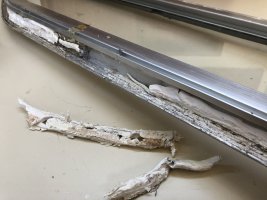
Lots of old caulk that the water got passed.
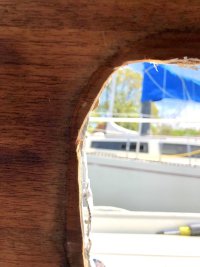
Maybe they cut this opening after a few beers at lunch??!!
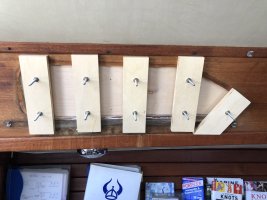
Temporary cover while fixed ports are being worked on.
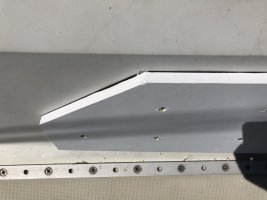
Temporary cover made from painted plywood with a foam strip between the cabin top and the cover.
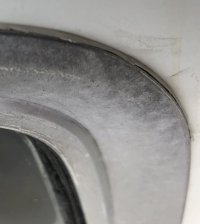
Trimmed butyl tape seal.
Attachments
Last edited:
Copied from https://ericsonyachts.org/ie/thread...-ports-master-thread.13578/page-3#post-166282 Post #52

. .

However, like yours, in some spots there was precious little overlap between the portlight frame and the cabin sides.

Before reinstalling, I was inside adjusting the port for even placement in the hole. Then from the outside Donna drew a pencil line around the frame. We used this to lay out the tape which, in addition to aiding cleanup, allowed us to align the port. It was still tricky because of the caulk squeeze-out over the tape. By the fourth portlight we about got it right.

s/v "Kismet", E35-3 hull # 238 (1986) Universal 25 w/ some XP upgrades
We found this too, though the actual cut-outs weren't as bad as some people have shown and there was a tight contact between FG outer shell and plywood inner fascia.Mr. Scarlett said:
. . .
One thing that blew me away was the absolutely horrible cutouts on both. Rough, wavy, bulging. The larger port has less than 1/8" of cabin sides to bond to on one of the upper corners. This does not take away from the build quality of mine or anyone else's Ericson, but wow.
. .
However, like yours, in some spots there was precious little overlap between the portlight frame and the cabin sides.
Before reinstalling, I was inside adjusting the port for even placement in the hole. Then from the outside Donna drew a pencil line around the frame. We used this to lay out the tape which, in addition to aiding cleanup, allowed us to align the port. It was still tricky because of the caulk squeeze-out over the tape. By the fourth portlight we about got it right.
s/v "Kismet", E35-3 hull # 238 (1986) Universal 25 w/ some XP upgrades
peaman
Sustaining Member
Can you describe this in more detail? Did you use no pre-made gasket material at all, and only butyl? Isn't a gasket needed to keep the glass in the frame? Today, I pulled out two of my port lights and hope to pull the other two tomorrow, and I'd like to re-do the glass-to-frame installation before they get re-installed.Rather than trying to get the OEM black rubber I bedded the replacement panes with butyl and they've stayed dry as a bone.
It’s been several years and I believe there are more photos somewhere around here, but no I did not use pre-made gaskets. Was just on the boat last week and there were no leaks. I used the 3M black butyl that any auto parts store carries to seal the acrylic pane and hold it in a fixed position. Then used Dow 795 to fill the rest of the channels, which also will keep the panes from settling in the butyl over time. Each pane is essentially double sealed and Heaven help whoever needs to clean them out many years from now.Can you describe this in more detail? Did you use no pre-made gasket material at all, and only butyl? Isn't a gasket needed to keep the glass in the frame? Today, I pulled out two of my port lights and hope to pull the other two tomorrow, and I'd like to re-do the glass-to-frame installation before they get re-installed.
peaman
Sustaining Member
I have been following most of these threads on re-bedding of fixed port lights with great interest. I have read about, and experienced, the difficulty of removing port lights bedded with various modern squeeze-tube caulks. And I know that butyl tape, while great for bedding things bolted down, is not ideal for something as delicate as our fixed port lights. I can now share my limited experience in using an old-school product called Dolfinite for fixed port lights.
When I got my 1987 32-3 in spring of 2021, there was obvious rot at the aft corner of the aft-most port fixed light over the nav station. I posted about that issue nearly 2 years ago. Soon after that post, I removed that port light, cleaned it up, and rebedded it with Dolfinite. Dolfinite bedding compound has been around for a long time. It sells for around $80 for a quart, not much less by volume that 3M 4200, but it never goes off like an open tube of modern caulks, and it never hardens. And it is very easy to work with.
Two years after using Dolfinite on that one port light, with no signs of leaking, it was time to remove the other three fixed port lights for eventual rebedding. Aided by Anti-Bond, as recommended by Christian Williams, it took a total of about 4-1/2 hours to remove them (90 minutes each!). In contrast, I was able to remove the Dolfinite-bedded leak-free fourth port light in only eleven minutes.
When I eventually re-install the fixed port lights, they will be bedded with Dolfinite.
I have noticed, from my own port lights, and photos of others' here, that typically great massive gobs of "adhesive sealant" materials are commonly used for bedding these port lights. But it occurs to me that there is little need for "adhesive" for our port lights, but only for "sealing", and no need at all for "filling", which is all that most of that stuff is doing.
Dolfinite spreads with the consistency of thin peanut butter, so it is easy to apply. Cleanup is easy, and can be expedited with mineral spirits. The manufacturer claims that it never hardens, but instead it can dry or cure to something like a stiff wax. When I re-bedded my port aft port light, I applied the Dolfinite to the aluminum flange only, where it comes in close contact with the fiberglass hull. There is no value in material placed between the port light frame and the hull material, except at the outboard surface. After installation of the interior trim for the port light, a cloth soaked with mineral spirits can easily remove any Dolfinite which oozes out from between the frame and the hull.
After struggling to remove the port lights, with concerns about breaking the glass, damaging the hull, warping the frame, and even whether successful removal is possible, the ease of using Dolfinite bedding compound looks really appealing.
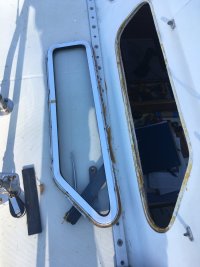
Port light removed after two leak-free years after bedding with Dolfinite. Elapsed time for removal: 11 minutes.
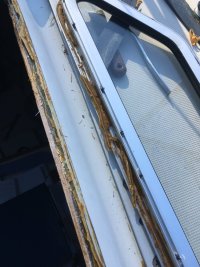
Dolfinite bedding compound after 2 years. It resembles a stiff wax.
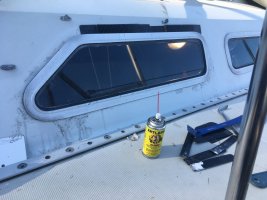
Waiting for the Anti-Bond to break down the caulking. Lots of wedges in use in hopes of breaking the bond.
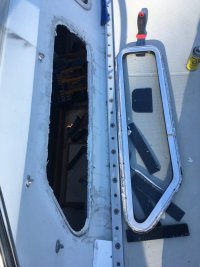
Ninety minutes of struggle, using Anti-Bond, the fixed port light finally lets go.
When I got my 1987 32-3 in spring of 2021, there was obvious rot at the aft corner of the aft-most port fixed light over the nav station. I posted about that issue nearly 2 years ago. Soon after that post, I removed that port light, cleaned it up, and rebedded it with Dolfinite. Dolfinite bedding compound has been around for a long time. It sells for around $80 for a quart, not much less by volume that 3M 4200, but it never goes off like an open tube of modern caulks, and it never hardens. And it is very easy to work with.
Two years after using Dolfinite on that one port light, with no signs of leaking, it was time to remove the other three fixed port lights for eventual rebedding. Aided by Anti-Bond, as recommended by Christian Williams, it took a total of about 4-1/2 hours to remove them (90 minutes each!). In contrast, I was able to remove the Dolfinite-bedded leak-free fourth port light in only eleven minutes.
When I eventually re-install the fixed port lights, they will be bedded with Dolfinite.
I have noticed, from my own port lights, and photos of others' here, that typically great massive gobs of "adhesive sealant" materials are commonly used for bedding these port lights. But it occurs to me that there is little need for "adhesive" for our port lights, but only for "sealing", and no need at all for "filling", which is all that most of that stuff is doing.
Dolfinite spreads with the consistency of thin peanut butter, so it is easy to apply. Cleanup is easy, and can be expedited with mineral spirits. The manufacturer claims that it never hardens, but instead it can dry or cure to something like a stiff wax. When I re-bedded my port aft port light, I applied the Dolfinite to the aluminum flange only, where it comes in close contact with the fiberglass hull. There is no value in material placed between the port light frame and the hull material, except at the outboard surface. After installation of the interior trim for the port light, a cloth soaked with mineral spirits can easily remove any Dolfinite which oozes out from between the frame and the hull.
After struggling to remove the port lights, with concerns about breaking the glass, damaging the hull, warping the frame, and even whether successful removal is possible, the ease of using Dolfinite bedding compound looks really appealing.

Port light removed after two leak-free years after bedding with Dolfinite. Elapsed time for removal: 11 minutes.

Dolfinite bedding compound after 2 years. It resembles a stiff wax.

Waiting for the Anti-Bond to break down the caulking. Lots of wedges in use in hopes of breaking the bond.

Ninety minutes of struggle, using Anti-Bond, the fixed port light finally lets go.
Last edited:
Yes, Tally Ho seems to be just about floating in Dolfinite. I was unfamiliar. There are of course many other suitable products.
peaman
Sustaining Member
Dolfinite is generally (only?) available in 1 quart size cans. I have been applying the stuff with a putty knife, but that can be kind of challenging to keep things neat and to get an even application where needed on port light flanges and hatch landings. Today, I purchased a pair of West System "Fillable Caulking Tubes 810" and packed one with Dolfinite. I cut the tip of the tube at an angle, for an opening of about 1/4". I loaded the tube into my caulk gun, and was able to prep a port light in half the time as using a putty knife, and with minimum mess. After my present round of rebedding port lights, I will discard any Dolfinite remaining in the tube, and possibly plan to reuse the cleaned tube in the future. A bonus advantage of using the caulking tubes is that that means less time that the Dolfinite in the can is left exposed, so its shelf life can be extended.
R22QuietThing
Junior Member
Last summer, I re-sealed my 4 big portlights, which had been glued in with injected Sikaflex. I NEVER want to deal with a glued in frame again. I went with Bed-It brand butyl tape. Christian has a point about the screws not *necessarily* pulling the frames together tightly enough, but with some imagination and the right size screws the fit can be done as well as possible. Happy to have no leaks this winter.
-Will A.
Pt. Richmond CA
1970 35-2 "Valkyrie"
-Will A.
Pt. Richmond CA
1970 35-2 "Valkyrie"
My turn - Just removed the fixed trapezoid portlights from Rumour as part of the project to sand, fair, and paint the deck head: https://ericsonyachts.org/ie/threads/fairing-sanding-and-painting-the-deckhead.21367/ I'm about to inject CPES into the running boards in the cabin ceiling and thought, "why go to all this trouble and not take care of the veneer. Sealing the veneer and then fairing over it will create a nice transition to the deck head/ceiling.
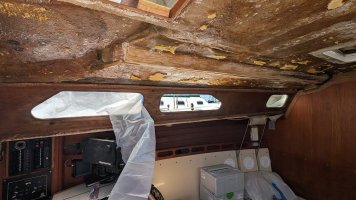
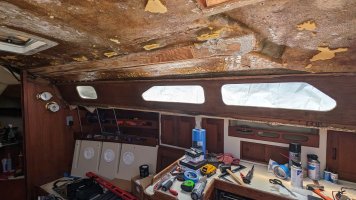
The first three were removed with relative ease. Bright white silicon was cut with a multi-tool and a thin scraping blade followed by a razor blade. A little prying and presto! The fourth trapezoid took several hours. It was bedded with a more chalky sealant that was pliable but very dense. Maybe Sikiflex? It had an odd odor to it.
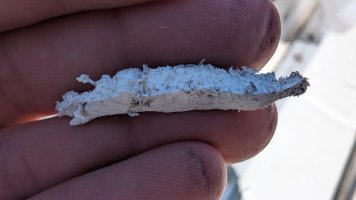
One of the portlights had no sealant left at the bottom aft corner. Sunlight crept through the crack between frame and fiberglass

Some of the frames were in bad shape. The seals/gaskets on the glass were loose. I'm sure water was getting in a couple different ways. I'm not anticipating a high success rate for rebuilding them. And I'd like the windows to be tinted, similar to the Lewmar Size 1 opening portlights I'll be installing in the forward section of the cabin. I've sent some measurements to Bomon (www.bomon.com) to get a quote for new windows. Also, had a wonderful conversation with the owner, Jannie (yaw-nee).


The first three were removed with relative ease. Bright white silicon was cut with a multi-tool and a thin scraping blade followed by a razor blade. A little prying and presto! The fourth trapezoid took several hours. It was bedded with a more chalky sealant that was pliable but very dense. Maybe Sikiflex? It had an odd odor to it.

One of the portlights had no sealant left at the bottom aft corner. Sunlight crept through the crack between frame and fiberglass

Some of the frames were in bad shape. The seals/gaskets on the glass were loose. I'm sure water was getting in a couple different ways. I'm not anticipating a high success rate for rebuilding them. And I'd like the windows to be tinted, similar to the Lewmar Size 1 opening portlights I'll be installing in the forward section of the cabin. I've sent some measurements to Bomon (www.bomon.com) to get a quote for new windows. Also, had a wonderful conversation with the owner, Jannie (yaw-nee).
My boat had DIY tint film on the fixed ports, so that's an option.
I removed it to lighten things up below.
I removed it to lighten things up below.
Super rough estimate from Bomon: about $750 a window. That could go up or down depending on things like frame anodizing, etc. I failed to ask if that was CAD or USD (but it would be even better if CAD).
Their process includes Bomon sending templates for me to hold in the opening of the portlight. Then I trace the opening to get an exact dimension of what they should build. I also have some decisions to make, like acrylic or tempered glass. I'm leaning towards acrylic, which scratches more easily but is more break resistant than tempered glass...
Their process includes Bomon sending templates for me to hold in the opening of the portlight. Then I trace the opening to get an exact dimension of what they should build. I also have some decisions to make, like acrylic or tempered glass. I'm leaning towards acrylic, which scratches more easily but is more break resistant than tempered glass...
phildogginit
Member II
Super rough estimate from Bomon: about $750 a window. That could go up or down depending on things like frame anodizing, etc. I failed to ask if that was CAD or USD (but it would be even better if CAD).
Their process includes Bomon sending templates for me to hold in the opening of the portlight. Then I trace the opening to get an exact dimension of what they should build. I also have some decisions to make, like acrylic or tempered glass. I'm leaning towards acrylic, which scratches more easily but is more break resistant than tempered glass...
Did you end up getting replacements from Bomon?
How did the project go?
Order placed and all four windows have been in production for a couple weeks. More precise prices are $625 for smaller forward windows and $720 for larger aft. Still need to work out shipping...
Windows have been shipped. Total cost: $625 x 2 + $720 x 2 + $175 (shipping to SF, CA) == $2865. Will post again once I have them and closer to installation.
Update:
The new trapezoid windows are installed! When the frames arrived I was impressed. They appear much more sturdily built than the original trapezoid fixed portlights. And the compression trim that mounts on the inside of the window opening has a lot more functional compressive strength. The frames are clear anodized aluminum and the panes are 6mm tempered glass with a 44% tint.
Installation was only slightly complicated by the new windows being slightly larger than the existing openings. This gave me an opportunity to sand down the edges and corners of the openings, which originally seemed to be cut by drunk monkeys. As my slip neighbor said, "the boat builders were probably be paid per boat, not per hour"
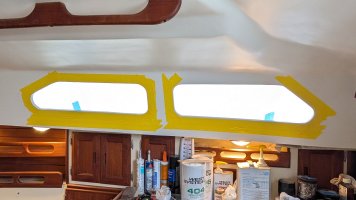
With freshly sanded openings, I took some time to reseal the edge of the veneer wood with the fiberglass outer shell with un-thickened West System epoxy. If water actually did make its way past the new windows, I didn't want it soaking the veneer which is so carefully hidden under many layers of epoxy primer and Awlgrip topcoat.
The instructions for bedding said to use the included neoprene adhesive strips -- no bedding compound, silicone, or caulk needed. There was more than enough neoprene in the box, so I have extra in case these need to be re-bedded in the future.
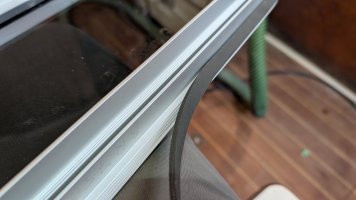
I slapped some Tef-gel on the 316 SS #8 x 3/4" screws to avoid any oxidation between the aluminum and the stainless. There are some undulations on the inside side of the cabin from fairing and painting. The trim pieces show this if you look closely enough -- but, outside the neoprene strips are compressed pretty well.
I'm looking forward to a sea trial. They are getting a bit of a test with the rain we are getting currently.
The new trapezoid windows are installed! When the frames arrived I was impressed. They appear much more sturdily built than the original trapezoid fixed portlights. And the compression trim that mounts on the inside of the window opening has a lot more functional compressive strength. The frames are clear anodized aluminum and the panes are 6mm tempered glass with a 44% tint.
Installation was only slightly complicated by the new windows being slightly larger than the existing openings. This gave me an opportunity to sand down the edges and corners of the openings, which originally seemed to be cut by drunk monkeys. As my slip neighbor said, "the boat builders were probably be paid per boat, not per hour"

With freshly sanded openings, I took some time to reseal the edge of the veneer wood with the fiberglass outer shell with un-thickened West System epoxy. If water actually did make its way past the new windows, I didn't want it soaking the veneer which is so carefully hidden under many layers of epoxy primer and Awlgrip topcoat.
The instructions for bedding said to use the included neoprene adhesive strips -- no bedding compound, silicone, or caulk needed. There was more than enough neoprene in the box, so I have extra in case these need to be re-bedded in the future.

I slapped some Tef-gel on the 316 SS #8 x 3/4" screws to avoid any oxidation between the aluminum and the stainless. There are some undulations on the inside side of the cabin from fairing and painting. The trim pieces show this if you look closely enough -- but, outside the neoprene strips are compressed pretty well.
I'm looking forward to a sea trial. They are getting a bit of a test with the rain we are getting currently.

